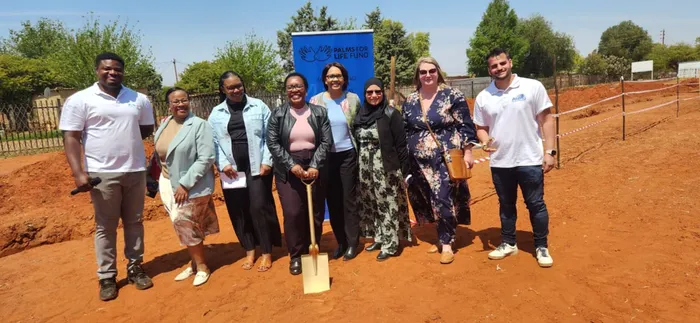Groundbreaking for ultra-modern ECD centre in Platfontein

Members of the Palms for Life Fund team, along with officials from the Northern Cape Department of Education, at the sod turning ceremony for the new ECD centre in Platfontein. Picture: Supplied
IN AN EFFORT to develop and preserve the !Xun and Khwedam San languages predominantly spoken by the !Xun and Khwe communities in Platfontein, located outside Kimberley, an ultra-modern early childhood development (ECD) centre valued at over R11 million is set to begin construction.
Thursday marked the groundbreaking ceremony for this significant project.
The ECD centre is being funded by the Palms For Life Fund, an organisation based in New York dedicated to the development of San people in Southern Africa.
Itunu Bodunrin, the project co-ordinator for the Palms For Life Fund, stated that the ECD centre aims not only to develop the community but also to ensure that learners are taught in their mother tongue from the foundation phase.
Bodunrin said that the Palms For Life Fund believes that the languages of the San people are in dire condition due to their limited teaching in mainstream education.
“We are collaborating with the provincial Department of Education to make the languages spoken by the two tribes in the area the medium of instruction for 160 learners aged between two and five years old. We believe that when these languages are taught in schools, they can become sustainable,” said Bodunrin.
He added that the project will not only benefit the area but also provide local employment and training opportunities.
“The 17 teachers and principal who will be working at the ECD are all from Platfontein. These individuals are currently receiving training in ECD NQF 4 and NQF 5,” said Bodunrin.
“We have built a number of these ECD centres across communities in Southern Africa, including Botswana and Namibia. The same contractor employed to develop the ECD in Namibia will be employed on this project. We are pleased that in 10 months, there will be an ultra-modern building, equipped with a computer lab and flushing toilets, standing on these grounds, where children from both tribes will be taught in their own languages, helping to ensure that the languages do not die.”
Bodunrin said they also want to bring some relief to the community.
“When you walk around in San communities, you will find that these communities are often left behind. Their languages are not included or used as mainstream languages. Due to that, they are at times not considered when information is communicated. Development initiatives in areas where San communities live are also not at times rolled out.
“The Indigenous people do not fall into the racial categories of government. Most of these communities are just left to themselves. This project will not only help with ECD learning but also fight the stereotypes that are attached to Indigenous people.”